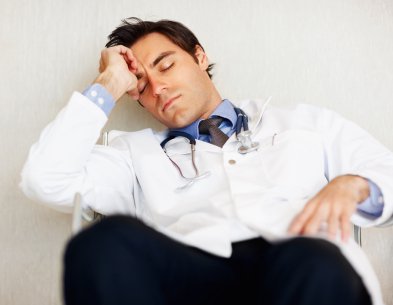Physician burnout rate decreases
The rate of burnout among U.S. physicians dropped in 2017 but still remains above 40%, according to findings published in Mayo Clinic Proceedings.
Tait D. Shanafelt, MD, of the department of medicine at Stanford University, and colleagues reviewed responses from 5,445 physicians who completed one of two surveys.
They found, based on the Maslach Burnout Inventory, 43.9% of physicians reported at least one symptom of burnout in 2017 compared with 54.4% in 2014 and 45.5% in 2011.
“Notably, the improvement in burnout among physicians has not been realized equally across all specialties, as levels remain higher than in 2011 for many disciplines,” Shanafelt and colleagues wrote.

Some of the specialties with the highest level of burnout in 2017 included emergency medicine and family medicine.
Researchers also found that 42.7% reported satisfaction with work-life integration, compared with 40.9% in 2014 and 48.5% in 2011, and that physicians were still at higher risk for burnout than those in other professions.
AMA’s president acknowledged the improvement but also did not declare victory.
“The tide has not yet turned on the physician burnout crisis,” AMA President Barbara L. McAneny, MD, said in a press release. “More work is needed to achieve meaningful change. Addressing the crisis requires continued investment from the health system in a comprehensive strategy that targets barriers to efficiently providing patients with high-quality care as the primary driver of physician burnout.”
“There is a strong economic and public health case for prioritizing a comprehensive strategy to reduce the work-induced syndrome of burnout and caregiver fatigue that is pushing physicians out of medicine. An energized, engaged and resilient physician workforce is essential to achieving national health goals,” she added.
To combat burnout, AMA has adopted policies that are intended to improve physicians’ access to mental health care services while reducing associated stigma to allow physicians to seek necessary care without fear of penalization or licensing restrictions and that call on state medical boards to evaluate a physician’s mental and physical health similarly.
Other medical societies have also addressed physician burnout among their members.

Approximately 2 years ago, AAFP launched the Physician Health First initiative, designed to publish timely and informative journal articles on topics related to physician well-being on an ongoing basis; create an enhanced well-being portal on AAFP’s website; develop a web-based well-being planning tool; and expand related CME tracks and workshops. In addition, the Academy will host its second annual Family Physician Health and Well-being Conference later this year.
ACP’s initiative, called Patients Before Paperwork, includes promoting individual well-being, improving the practice and organizational environment, fostering local communities of well-being and advocating for systems.
As a courtesy to its readers, Healio recently launched the Physician Burnout Resource Center, a collection of news articles and features on this issue from across all of Healio.com.
Disclosures: The researchers report no relevant financial disclosures. McAneny is president of AMA.

